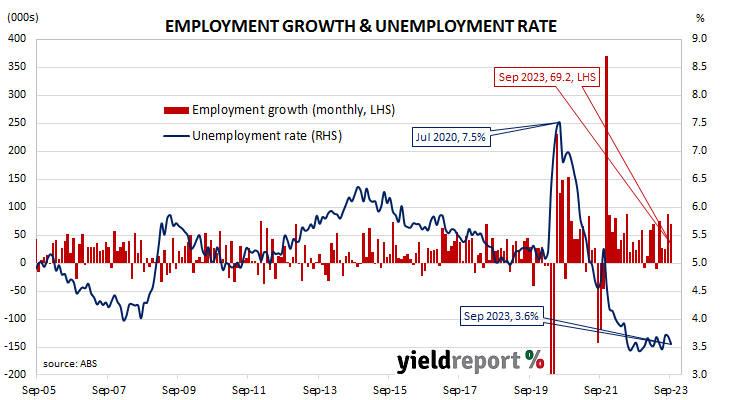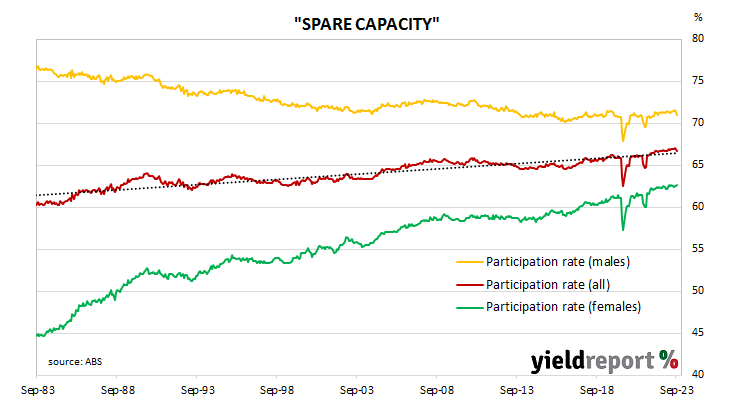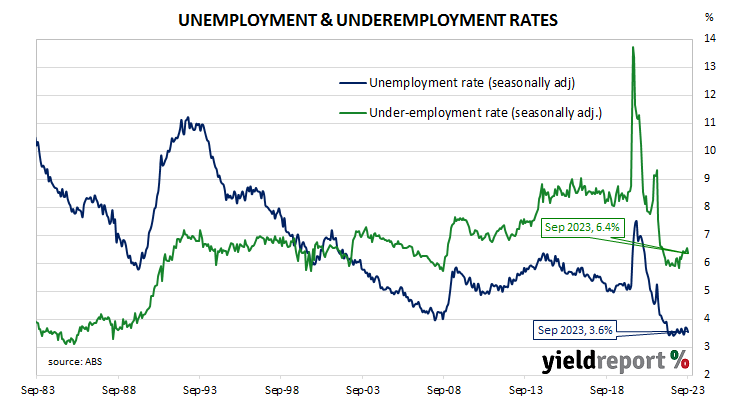Summary: Employment up 6,700 in September, less than expected; ANZ: figures point to cooling labour market; UBS: employment growth still booming at 2.9%; participation rate falls back to 66.7%; jobless rate ticks down to 3.6%; more part-time, fewer full-time jobs; aggregate work hours down 0.4%; underemployment rate down from 6.5% to 6.4%.
Australia’s period of falling unemployment came to an end in early 2019 when the jobless rate hit a low of 4.9%. It then averaged around 5.2% through to March 2020, bouncing around in a range from 5.1% to 5.3%. Leading indicators such as ANZ-Indeed’s Job Ads survey and NAB’s capacity utilisation estimate suggested the unemployment rate would rise in the June 2020 quarter and it did so, sharply. The jobless rate peaked in July 2020 but fell below 7% a month later and then trended lower through 2021 and 2022.
The latest Labour force figures have now been released and they indicate the number of people employed in Australia according to ABS definitions increased by 6,700 in September. The result was less than the 20,000 increase which had been generally expected and well down on August’s 63,300 rise after revisions.
“The soft headline employment print, the fall in full-time employment and hours worked and the decline in labour force participation point to a cooling labour market,” said ANZ Head of Australian Economics Adam Boyton.
Domestic Treasury bond yields rose noticeably on the day following upwards moves of long-term of US Treasury yields overnight. By the close of business, the 3-year ACGB yield had added 7bps to 4.26%, the 10-year yield had gained 13bps to 4.80% while the 20-year yield finished 14bps higher at 5.18%.
In the cash futures market, expectations regarding further rate rises firmed a little. At the end of the day, contracts implied the cash rate would increase from the current rate of 4.07% and average 4.15% through November, 4.205% in December and 4.275% in February. May 2024 contracts implied a 4.355% average cash rate while August 2024 contracts implied 4.365%, 30bps more than the current rate.
“Given the Labour Force Survey is very volatile month to month, we focus on the average over several months, which has cooled slightly to around 25,000, from 30,000 to 40,000 previously,” said UBS economist George Tharenou. “That said, the year-on-year [growth rate] is still booming at 2.9%.
The participation rate fell back from August’s figure of 67.0% to 66.7% as the total available workforce decreased by 13,100 to 14.632 million while the number of unemployed persons declined by 19,800 to 520,500. As a result, the unemployment rate ticked down from 3.7% to 3.6%.
The aggregate number of hours worked across the Australian economy decreased by 0.4% as 46,500 residents gained part-time positions and 39,800 residents lost full-time positions. On a 12-month basis and after revisions, aggregate hours worked increased by 2.9% as 154,700 more people held part-time positions and 239,600 more people held full-time positions than in September 2022.
More attention has been paid to the underemployment rate in recent years, which is the number of people in work but who wish to work more hours than they do currently. September’s underemployment rate declined from August’s revised figure of 6.5% to 6.4%, 0.6 percentage points above this cycle’s low.
The underutilisation rate, that is the sum of the underemployment rate and the unemployment rate, has a strong correlation with the annual growth rate of the ABS private sector wage index when advanced by two quarters. September’s underutilisation rate of 10.0% corresponds with an annual growth rate of about 4.2%.




